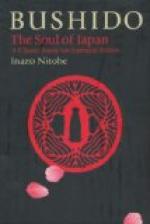The question that concerns us most is, however,—Did Bushido justify the promiscuous use of the weapon? The answer is unequivocally, no! As it laid great stress on its proper use, so did it denounce and abhor its misuse. A dastard or a braggart was he who brandished his weapon on undeserved occasions. A self-possessed man knows the right time to use it, and such times come but rarely. Let us listen to the late Count Katsu, who passed through one of the most turbulent times of our history, when assassinations, suicides, and other sanguinary practices were the order of the day. Endowed as he once was with almost dictatorial powers, repeatedly marked out as an object for assassination, he never tarnished his sword with blood. In relating some of his reminiscences to a friend he says, in a quaint, plebeian way peculiar to him:—“I have a great dislike for killing people and so I haven’t killed one single man. I have released those whose heads should have been chopped off. A friend said to me one day, ’You don’t kill enough. Don’t you eat pepper and egg-plants?’ Well, some people are no better! But you see that fellow was slain himself. My escape may be due to my dislike of killing. I had the hilt of my sword so tightly fastened to the scabbard that it was hard to draw the blade. I made up my mind that though they cut me, I will not cut. Yes, yes! some people are truly like fleas and mosquitoes and they bite—but what does their biting amount to? It itches a little, that’s all; it won’t endanger life.” These are the words of one whose Bushido training was tried in the fiery furnace of adversity and triumph. The popular apothegm—“To be beaten is to conquer,” meaning true conquest consists in not opposing a riotous foe; and “The best won victory is that obtained without shedding of blood,” and others of similar import—will show that after all the ultimate ideal of knighthood was Peace.
It was a great pity that this high ideal was left exclusively to priests and moralists to preach, while the samurai went on practicing and extolling martial traits. In this they went so far as to tinge the ideals of womanhood with Amazonian character. Here we may profitably devote a few paragraphs to the subject of
THE TRAINING AND POSITION OF WOMAN.
The female half of our species has sometimes been called the paragon of paradoxes, because the intuitive working of its mind is beyond the comprehension of men’s “arithmetical understanding.” The Chinese ideogram denoting “the mysterious,” “the unknowable,” consists of two parts, one meaning “young” and the other “woman,” because the physical charms and delicate thoughts of the fair sex are above the coarse mental calibre of our sex to explain.




